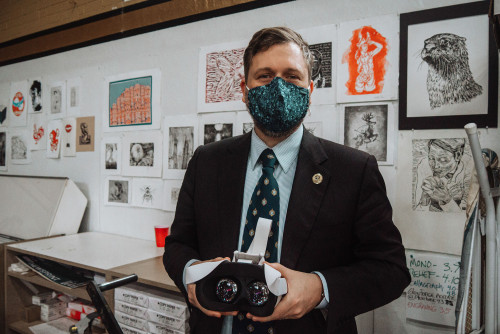
By Anna Ostmann
Since its inception four years ago, Lindenwood’s Masters in Art History and Visual Culture has repeatedly been ranked as one of the top programs in the subject. Most recently, Best Value Schools included it in its “Best 8 Online Master’s in Art and Art History in 2021.”
As the ranking explains, the 30-credit hour online program gives students a broad foundation in the visual art and culture of different eras, providing them with the opportunity to explore art and culture throughout history, as well as helping them develop strong research practices and knowledge of “how works of art were produced and how they were utilized through different eras.”
Current events in the past year and a half resulted in a sudden and urgent need for engaging online education, and many programs had to rapidly shift from on-ground courses to online and hybrid set-ups, often to the detriment of student learning. However, Lindenwood’s Art History MA was designed from the outset as a fully online program, with in-person coursework being entirely optional. The program is tailored to accommodate non-traditional students, such as those who are returning to school while working and/or caring for children full-time, as well as students in different countries and time zones, providing them with an enriching education that does not sacrifice quality for convenience.
According to Dr. James Hutson, the Department Head of Art History and Visual Culture at Lindenwood, the program has several key features that promote student engagement on digital platforms and enrich their education with technology:
Every art history graduate student is enrolled in a zero-credit hour practicum, which brings everyone in the program together and fosters an online community outside of their individual classes. The practicum also augments their coursework with additional learning opportunities, such as inviting guest speakers, including museum curators, educators, and other professionals, to come and talk about specific subjects or careers paths. These talks are recorded so that any students who were unavailable at the time of the presentation itself can still benefit. Furthermore, the practicum has online discussion boards so that students can engage with each other about the talks and other relevant subjects asynchronously.
The program’s use of Virtual Reality (VR) technology opens up new opportunities for immersive learning. VR allows professors to guide students through tours of museums and specific destinations, such as the pyramids at Giza, during which they can interact with their professor and other students’ avatars (these tours are also recorded for students’ convenience).
Students in the program also have access to resources for coursework, research, and career planning through Canvas. Dr. Hutson explained that the faculty wants to make sure students, regardless of location, time zone, or availability, have access to whatever resources they may need, on-demand.
Outside the digital platform, the program also includes on-the-ground enrichment opportunities with domestic study “away” trips, such as visiting the Smithsonian Museums in Washington DC, and with study abroad trips, including an upcoming faculty-led course in Florence, Italy in May 2022.
Overall, Lindenwood’s Masters of Art History and Visual Culture program takes advantage of today’s technology to provide students with real experience and opportunities for real success, even from a distance.

The Linden Gold
The Linden Gold is a student operated organization focusing on promoting the academic success and achievements of Lindenwood. Through stories about alumni, current students, and faculty alike, The Linden Gold strives to engage with the St. Charles Community and showcase the unique greatness of Lindenwood.












